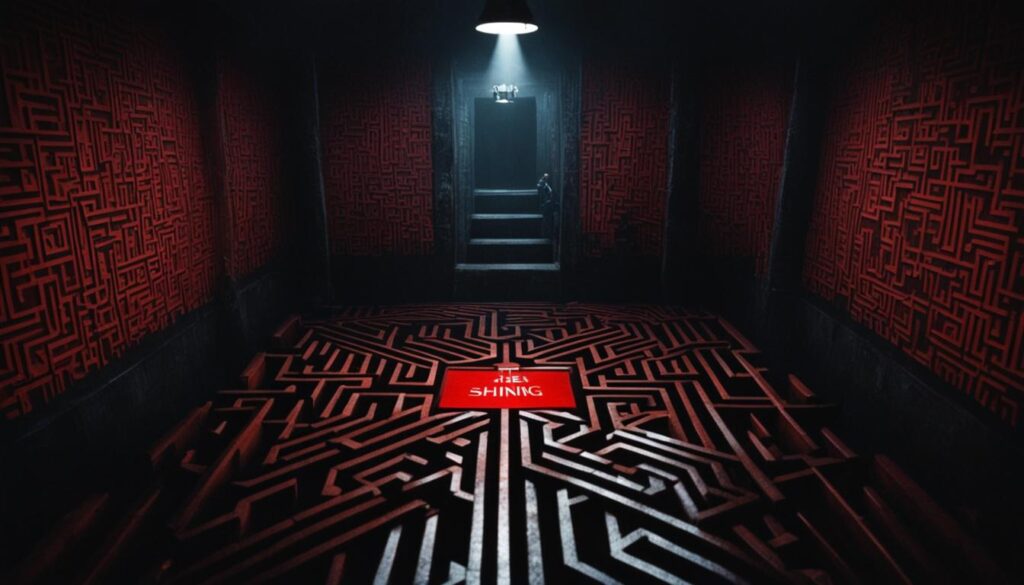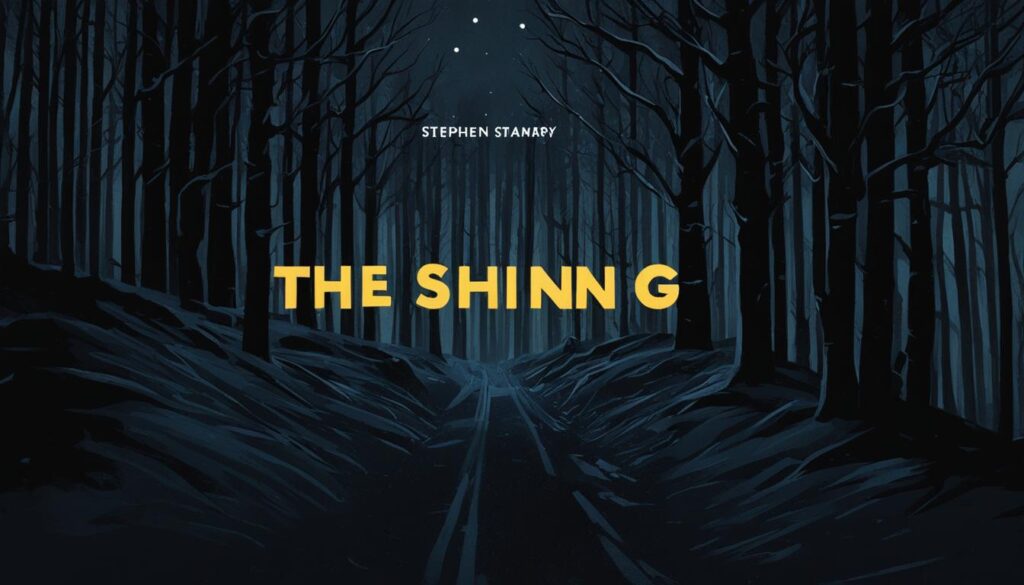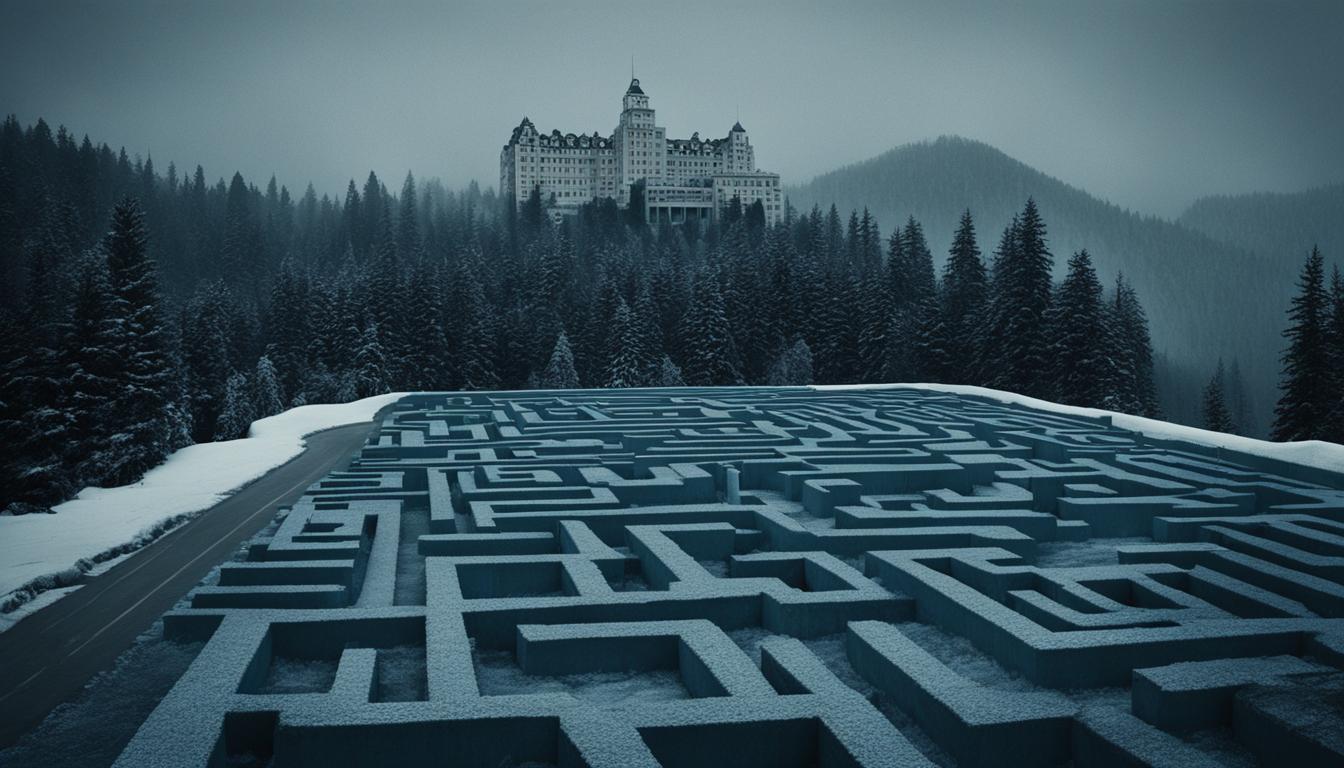In this section, we will explore the audiobook review of Stephen King’s masterpiece horror novel, The Shining. The audiobook version, narrated by Campbell Scott, offers an immersive experience that brings to life the eerie atmosphere of the Overlook Hotel. First published in 1977, The Shining has become a haunting classic, cementing King’s reputation as the master of horror.
Whether you’re a die-hard fan or a newcomer to King’s writing, The Shining is an essential addition to any horror lover’s library. In this section, we will delve into the details of the audiobook version, exploring the narrator’s performance, pacing, and the overall effectiveness of the adaptation. Let’s journey through the twisted corridors of the Overlook Hotel and see why The Shining remains a timeless favorite.
Stephen King’s “The Shining”
In 1974, Stephen King and his wife, Tabitha, spent one night at the Stanley Hotel in Estes Park, Colorado. King was inspired by the hotel’s eerie atmosphere and began writing a story about a haunted hotel. This work became The Shining, which King referred to as “a novel of psychic power” (Rolling Stone).
King’s writing style in The Shining is characterized by his signature blend of horror and psychological suspense. He deftly explores themes of isolation, addiction, and the supernatural, delving into complex character motivations and driving the narrative forward with escalating tension. King’s vivid descriptions of the Overlook Hotel, both inside and out, create an ominous setting that takes on a life of its own.
“All work and no play makes Jack a dull boy.”
First published in 1977, The Shining received immediate critical acclaim. It was a bestseller and quickly became a classic, cementing King’s reputation as a master of horror. The novel has since been adapted into a variety of visual media, most notably the 1980 film directed by Stanley Kubrick and the recent television series.
Plot Synopsis
In “The Shining,” Jack Torrance, a struggling writer, takes up the job of a winter caretaker at the Overlook Hotel in Colorado, hoping to work on his novel and mend his fractured family relationships. Together with his wife, Wendy, and young son, Danny, Jack moves into the isolated hotel, hoping to find peace and solitude. However, as winter sets in, the family starts experiencing supernatural occurrences that seem to be linked to the hotel’s dark past.
Danny’s unique gift of “the shining” – a psychic ability to see visions of the past and future – also begins to manifest, as the malevolent spirits of the Overlook become more powerful. Jack slowly descends into madness under the influence of the hotel’s sinister forces, turning on his family in a violent attempt to possess Danny’s gift and become the hotel’s permanent caretaker.
The novel ends with a dramatic showdown between Jack and his family, culminating in a tragic but fitting conclusion.
“The Shining is one of his [Stephen King’s] most effective ghost stories.” – The New York Times Book Review
Setting: The Overlook Hotel
In “The Shining,” the Overlook Hotel serves as more than just a backdrop for the story. Its presence is woven into the fabric of the narrative, with its history, layout, and mysterious elements making it a character in its own right.
The establishment, set in the remote Colorado wilderness, is a labyrinthine maze of corridors, rooms, and secret passages, with the potential for danger lurking around every corner.
One of the hotel’s most captivating features is the giant maze located in its garden, which plays a critical role in the story’s climax. The ominous hedge animals that populate the maze come to life, and their menacing presence heightens the sense of dread and terror that permeates throughout the book.
Additionally, the Overlook is steeped in a dark past that manifests itself in a multitude of ways throughout the novel. The malevolence that haunts the hotel is palpable, and the sense of isolation and madness that it generates in its inhabitants is a key element of the narrative.
| History of the Overlook Hotel | Layout of the Overlook Hotel | Mysterious elements of the Overlook Hotel |
|---|---|---|
| – The Overlook is built on a Native American burial ground – Many gruesome deaths have occurred on its premises |
– The hotel is a massive, sprawling complex with numerous wings and floors. – It has a hedge maze in its garden that plays a significant role in the story. |
– The hotel’s very own ghosts and demons. – The room 217 where many deaths occurred. |
The setting of the Overlook Hotel is an indelible aspect of “The Shining” and King’s masterful ability to create a mood and atmosphere that is both haunting and mesmerizing.
Character Analysis
“The Shining” is hailed for its complex and well-developed characters. From the protagonist Jack Torrance to his wife Wendy and son Danny, each character brings their own psychological complexities that propel the narrative forward.
Jack Torrance
Jack Torrance, a recovering alcoholic and struggling writer, is the main character. By taking a job as a caretaker at the Overlook Hotel, he hopes to find inspiration for his writing and reconnect with his family. However, his inner demons and the hotel’s malevolent presence quickly lead him down a path of madness and violence.
“Here’s to five miserable months on the wagon, and all the irreparable harm it has caused me.”
― Jack Torrance
Wendy Torrance
Wendy Torrance is Jack’s wife and the mother of Danny. She is depicted as caring, protective, and loyal to her family, but also as a victim of domestic abuse. As she and Danny become caught in the horrors of the Overlook, Wendy becomes resolute and resourceful, fighting to protect her son and herself from Jack’s descent into madness.
Danny Torrance
Danny Torrance, with his psychic abilities, is the most important character in the book. He is often referred to by the hotel’s ghosts as “Doc” and his visions of the hotel’s past and present are crucial to the story. As Jack’s grip on reality wanes, Danny’s powers become more important, as he attempts to use them to save himself and his mother from Jack’s wrath and the terrifying forces of the hotel.
Overall, “The Shining” is a character-driven story that explores the psychological depths of its protagonists. Each character is essential to the narrative and adds to the tension and horror of the story, making it a true horror classic.
Themes Explored
In “The Shining,” Stephen King weaves a complex narrative that explores several prominent themes. These themes are integral to the story’s development and contribute to its overall chilling atmosphere. Here, we will examine four major themes present in the novel:
| Theme | Description |
|---|---|
| Isolation | The isolation of the Torrance family at the Overlook Hotel serves as a catalyst for the story’s suspense and horror. The vast, empty hotel, cut off from the outside world by harsh winter weather, creates an intense feeling of claustrophobia and desperation. |
| Madness | The psychological breakdown of Jack Torrance and the inevitable descent into madness is a central theme in the novel. The Overlook Hotel’s dark history and sinister presence fuel Jack’s unraveling until he becomes a terrifying figure that threatens the safety of his family. |
| Family Dynamics | The dynamics of the Torrance family are central to the novel, with each member’s personal struggles and relationships contributing to the narrative’s tension and conflict. The love and loyalty between Danny, Wendy, and even Jack are contrasted with the violence and desperation of their situation. |
| Supernatural Elements | The Overlook Hotel’s spectral inhabitants and supernatural phenomena give the story a haunting edge. King’s use of the supernatural emphasizes the building’s inherent evil and the darkness that lurks within it. |
Isolation
The isolation of the Overlook Hotel creates a palpable sense of dread throughout “The Shining.” Stranded by a brutal winter and cut off from civilization, the Torrance family is forced to confront their inner demons and each other in the confined space of the hotel. The novel masterfully creates a tense, claustrophobic atmosphere that amplifies the horror and desperation of the characters’ situation.
Madness
The exploration of madness and the breakdown of the human psyche is a recurring theme in King’s work and is particularly emphasized in “The Shining.” The novel’s main character, Jack Torrance, is a man struggling with alcoholism and a history of domestic abuse who is driven to madness by the evil forces lurking in the hotel. His eventual transformation into a grotesque malevolent figure serves as a warning of the dangers of unchecked anger and violence.
Family Dynamics
The relationships between the Torrance family members provide a rich canvas for exploring the complex emotions and conflicts that arise in a family under duress. Wendy’s fierce maternal love for Danny is juxtaposed against her own struggles with self-doubt. Danny’s psychic abilities and Jack’s alcoholism and abusive past create tension and conflict that fuel the story’s progress.
Supernatural Elements
The supernatural is an ever-present force throughout “The Shining.” From the hotel’s ghastly history to the malevolent spirits that haunt its halls, these elements highlight the novel’s darker themes and amplify its horror. King’s use of the supernatural is masterful in its ability to generate suspense and create an overwhelming sense of terror.
Writing Style and Tone
Stephen King’s writing style in “The Shining” is distinctive and memorable. His use of suspense, foreshadowing, and descriptive language creates a haunting atmosphere that draws readers in from the very first page. King’s writing is often characterized by a dark, brooding tone that perfectly suits the horror genre.
Throughout “The Shining,” King employs a variety of literary techniques to create a palpable sense of tension and fear. He expertly builds suspense through the use of short, choppy sentences and carefully crafted cliff-hangers, leaving readers on the edge of their seats with each chapter.
King’s attention to detail in his descriptions of characters and settings is also a notable aspect of his writing. He brings the Overlook Hotel to life through vivid descriptions that paint a clear picture of its eerie corridors and mysterious history. Similarly, his depiction of the Torrance family and their relationships is both nuanced and engaging.
The tone of “The Shining” is dark and foreboding, with a sense of impending doom permeating the narrative. King expertly weaves together themes of isolation, madness, and supernatural horror to create a truly chilling reading experience. The audiobook version of “The Shining” only adds to this atmosphere, with the narrator’s haunting voice perfectly capturing the tone of King’s writing.
“It was like coming back to the world after a long fever. It was like coming back to a world where a thousand small details registered instead of just a dozen major ones, a world full of things demanding attention, questions wanting answers.”
Audiobook Narration
The audiobook version of “The Shining” provides a unique opportunity to experience Stephen King’s horror masterpiece in a new way. The narrator’s performance can make or break the audio experience, and luckily, “The Shining” audiobook does not disappoint.
The narrator’s voice acting captures the intense emotions and eerie atmosphere of the novel, transporting listeners to the haunted halls of the Overlook Hotel. The pacing of the narration is also well-done, keeping the suspense high and the story engaging. Overall, the audiobook version of “The Shining” is a gripping and effective way to experience the novel.
“Listening to ‘The Shining’ audiobook was a spine-chilling experience. The narrator’s voice gave me goosebumps and brought King’s words to life in a truly immersive way.” – Sarah J.
The Narrator’s Performance
| Aspect | Description |
|---|---|
| Voice Acting | The narrator’s voice acting is highly effective in conveying the emotions and tension of the story. |
| Pacing | The pacing of the narration is well-done, keeping the suspense high and the story engaging. |
| Attention to Detail | The narrator pays close attention to Stephen King’s descriptive language, enhancing the listener’s immersion in the story. |
Visual Adaptations
The success of “The Shining” novel gave rise to several visual adaptations. The most iconic of them was the 1980 horror film classic directed by Stanley Kubrick. The film dominated the box office, solidifying its place in popular culture.  Kubrick’s adaptation deviated from the original storyline of the book but still managed to capture the essence of the novel’s haunting atmosphere. The film’s eerie soundtrack, unsettling cinematography, and Jack Nicholson’s iconic performance as Jack Torrance created a chilling cinematic experience that still terrifies audiences today.
Kubrick’s adaptation deviated from the original storyline of the book but still managed to capture the essence of the novel’s haunting atmosphere. The film’s eerie soundtrack, unsettling cinematography, and Jack Nicholson’s iconic performance as Jack Torrance created a chilling cinematic experience that still terrifies audiences today.
In 1997, a television miniseries adaptation of “The Shining” aired, which was more faithful to the source material. Directed by Mick Garris, the miniseries starred Steven Weber as Jack Torrance and Rebecca De Mornay as Wendy Torrance. The production received mixed reviews, with some praising Weber’s performance, while others criticized its slow pace.
The most recent adaptation of “The Shining” was the 2019 film “Doctor Sleep,” directed by Mike Flanagan. The film was a sequel to the original story, following the adult life of Danny Torrance, the son of Jack Torrance. Although it received positive reviews, it failed to replicate the success of the original film.
The Table: Visual Adaptations Overview
| Name of the Adaptation | Year of Release | Director | Stars | Box Office |
|---|---|---|---|---|
| The Shining (movie) | 1980 | Stanley Kubrick | Jack Nicholson, Shelley Duvall, Danny Lloyd | $61.2 million |
| The Shining (miniseries) | 1997 | Mick Garris | Steven Weber, Rebecca De Mornay, Courtland Mead | N/A |
| Doctor Sleep | 2019 | Mike Flanagan | Ewan McGregor, Rebecca Ferguson, Kyliegh Curran | $72.3 million |
In conclusion, “The Shining” has had a significant impact on popular culture and influenced several visual adaptations. While the original film remains a horror classic, the newer adaptations have been met with mixed reviews. Nevertheless, fans and newcomers alike can enjoy these adaptations and compare them to King’s original masterpiece.
Critical Reception
Since its release in 1977, “The Shining” has been met with a range of critical responses. Some praised Stephen King’s masterful storytelling, while others criticized its pacing, character development, and overall disturbing content.
Despite initial mixed reviews, the cultural significance of “The Shining” cannot be denied. It has become a staple of the horror genre and influenced countless works in literature, film, and television. The novel’s themes, characters, and The Overlook Hotel have become iconic in popular culture.
“The Shining” is a masterpiece of American literature, and King’s most accomplished work. His frightening imagination is unlimited.” – John Dugdale, The Guardian
Over time, “The Shining” has remained a classic horror novel, with its critical reception generally positive. It continues to captivate audiences with its haunting imagery, vivid characters, and exploration of psychological terror.
Critical Reception of “The Shining”
| Critic | Publication | Review |
|---|---|---|
| Michiko Kakutani | The New York Times | “Mr. King has written a compulsive and brilliant novel… A master storyteller.” |
| Harlan Ellison | Los Angeles Times | “The Shining is Stephen King’s finest novel… A classic of modern horror.” |
| Publishers Weekly | Publication date | “The most strongly horrifying novel Stephen King has written… It will stir up nightmares and night sweat for years.” |
| Roger Ebert | Chicago Sun-Times | “The Shining is so relentlessly terrifying that it never lets up for a moment… It ranks with the best of supernatural horror.” |
Cultural Impact
Since its release in 1977, “The Shining” has had a significant cultural impact on the horror genre and popular culture as a whole. The novel’s exploration of psychological terror and the supernatural has influenced countless writers and filmmakers.
One of the most well-known visual adaptations of “The Shining” is Stanley Kubrick’s 1980 film starring Jack Nicholson. The movie has been praised for its atmospheric tension and iconic cinematography, and remains a staple of horror cinema to this day.
In addition to film adaptations, “The Shining” has been referenced in popular media such as television shows, music, and literature. The novel’s themes of isolation, madness, and family dynamics continue to resonate with audiences and inspire new works.
Overall, “The Shining” has left an indelible mark on the horror genre and popular culture. Its enduring legacy is a testament to the power of Stephen King’s storytelling and the lasting impact that great literature can have on society.
Psychological Analysis
In “The Shining,” Stephen King explores the depths of the human psyche through his masterful use of horror. The novel offers a fascinating glimpse into how fears and traumas can shape an individual’s perception of reality, ultimately leading to their downfall.
One of the central themes in the novel is the impact of isolation on the human mind. The protagonist, Jack Torrance, is a struggling writer who takes a job as the winter caretaker of the Overlook Hotel, a remote and isolated location cut off from the rest of the world. As he becomes increasingly isolated, Jack’s sanity begins to unravel, and he becomes consumed by the need to write his masterpiece.
The character of Danny also showcases how trauma can shape a person’s psyche. As a young child, Danny experiences a traumatic event that leaves him with a unique psychic ability known as “the shining.” Throughout the novel, Danny’s ability is both a source of strength and a danger, as it allows him to see the darkest corners of the human mind.
The Power of Fear
“The Shining” also explores the power of fear and how it can take on a life of its own. The novel’s supernatural elements, such as the haunted Overlook Hotel and the malevolent spirits that reside within, serve as a metaphor for the fears that haunt us all.
“Monsters are real, and ghosts are real too. They live inside us, and sometimes, they win.” – Stephen King, “The Shining”
King’s powerful use of imagery and his ability to tap into primal human emotions makes “The Shining” a truly terrifying masterpiece. By exploring the darkest corners of the human psyche, he creates a story that stays with readers long after they’ve finished reading.
Comparisons with Other King Novels
Stephen King is widely regarded as one of the greatest horror novelists of all time, and his work continues to frighten and delight readers around the world. In this section, we’ll compare “The Shining” to other notable novels by King, exploring the common themes and writing styles that make his work so beloved.
Common Themes
King is known for exploring themes of horror, fear, and trauma, and “The Shining” is no exception. However, he also delves into other themes, such as the power of the supernatural, the importance of family, and the impact of isolation. Other notable King novels that touch on these themes include:
| Novel | Main Themes |
|---|---|
| The Stand | The battle between good and evil, the apocalypse, the power of community |
| Carrie | Bullying, the dangerous consequences of ignorance and intolerance, the emergence of telekinesis |
| The Dark Tower series | The journey of self-discovery, the battle between order and chaos, the power of destiny |
Despite the different settings and scenarios of these novels, they all contain common themes that are explored with King’s unique style of storytelling.
Writing Style
King is also known for his distinctive writing style that blends vivid description, engaging dialogue, and suspenseful pacing. In “The Shining,” he uses these techniques to create a haunting atmosphere and keep readers on the edge of their seats. Other notable King novels that showcase his writing style include:
- It: Combines horror with coming-of-age themes, intricate character development, and a nonlinear narrative structure.
- The Green Mile: A heart-wrenching story that explores themes of justice and redemption with richly drawn characters and a powerful emotional arc.
- The Outsider: A blend of supernatural horror and crime fiction that masterfully builds tension toward a shocking conclusion.
Though these novels differ in plot, they all showcase King’s ability to craft compelling stories with memorable characters and resonant themes.

In conclusion, King’s body of work is a testament to his mastery of the horror genre, and “The Shining” remains a standout novel in his catalog. By exploring similarities and differences with other notable King works, readers can gain a deeper understanding of his unique style and enduring legacy.
Reader Recommendations
As one of the most iconic horror novels of all time, “The Shining” has captivated readers for decades. With the rise of audiobooks, many fans have found a new way to experience Stephen King’s chilling masterpiece. We’ve gathered some of the top reader recommendations to give you insight into the immersive audio experience that “The Shining” offers.
| Reader | Recommendation |
|---|---|
| Carla S. | “Listening to ‘The Shining’ on audiobook made me feel like I was right there in the Overlook Hotel. The narrator did an incredible job of bringing the story to life, and I found myself getting lost in the suspense and terror of the narrative. Highly recommended!” |
| John D. | “I’ve read ‘The Shining’ countless times, but listening to the audiobook added a whole new layer of depth and intrigue. The subtle inflections of the narrator’s voice really helped to emphasize certain moments in the story and kept me on the edge of my seat throughout.” |
| Emma L. | “If you’re a fan of horror, then the audiobook version of ‘The Shining’ is an absolute must-listen. The combination of King’s gripping prose and the narrator’s haunting voice is guaranteed to send shivers down your spine.” |
Overall, readers overwhelmingly recommend experiencing “The Shining” in audiobook format. Its immersive and atmospheric storytelling is made all the more chilling with the power of voice acting. As one of King’s most celebrated works, “The Shining” continues to inspire a new generation of horror fans.
Conclusion
In conclusion, Stephen King’s “The Shining” is a horror masterpiece that has captured the imaginations of readers for over four decades. Its immersive storytelling, memorable characters, and exploration of fear and trauma continue to resonate with readers today, cementing its place in the pantheon of horror literature. Whether experienced through the pages of the book or the chilling narration of the audiobook, “The Shining” remains a must-read (or listen) for fans of the genre.
From the eerie corridors of the Overlook Hotel to the psychological complexities of its characters, “The Shining” offers a hauntingly atmospheric journey that leaves a lasting impression. Its cultural impact, critical reception, and comparisons with other King novels only serve to reinforce its status as a classic of horror literature. To all those looking for an immersive, spine-tingling experience – look no further than “The Shining.”



